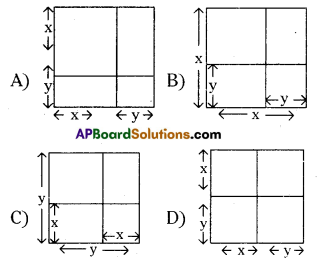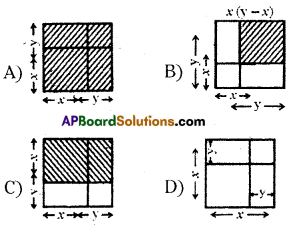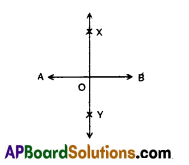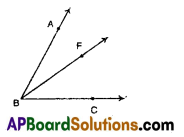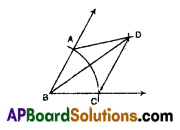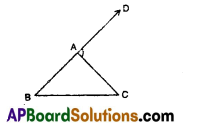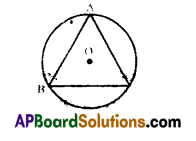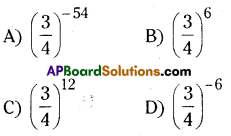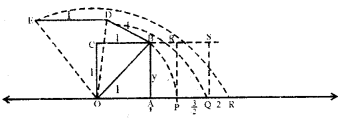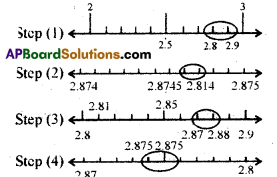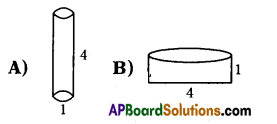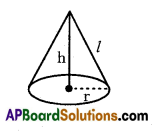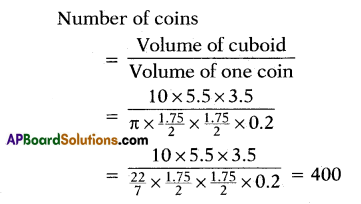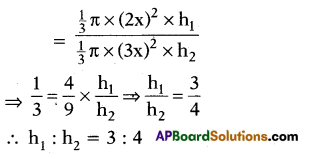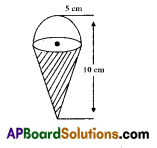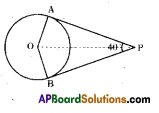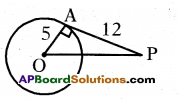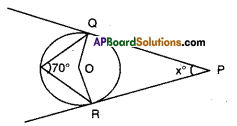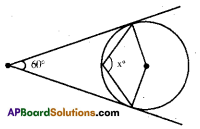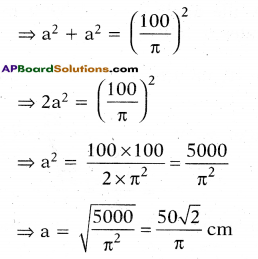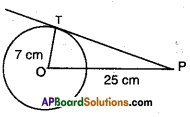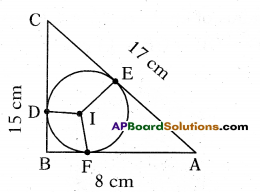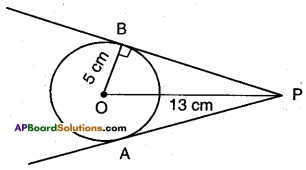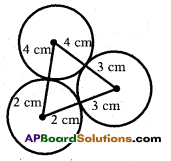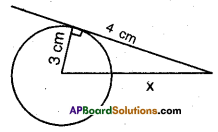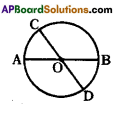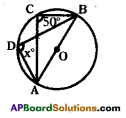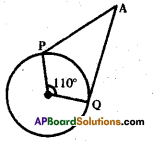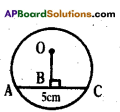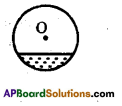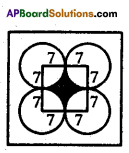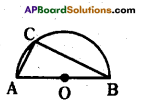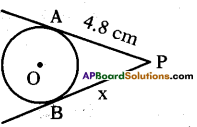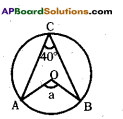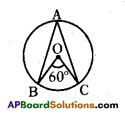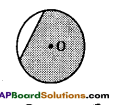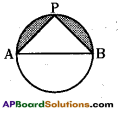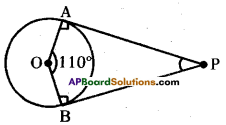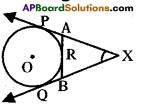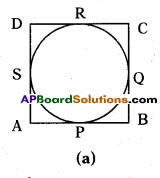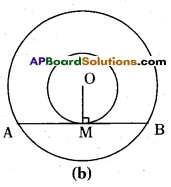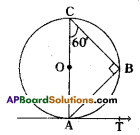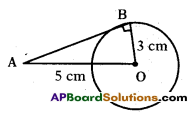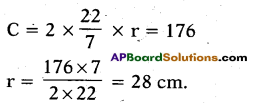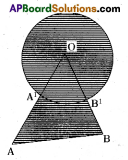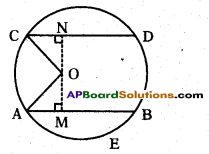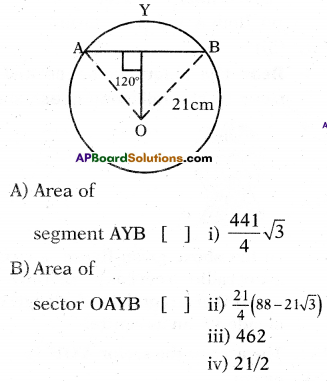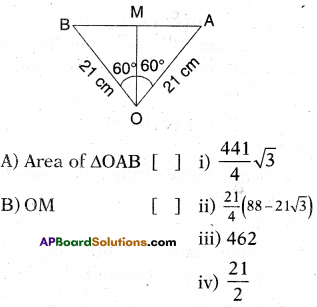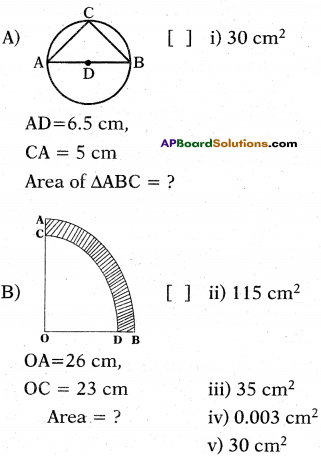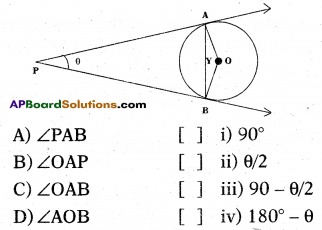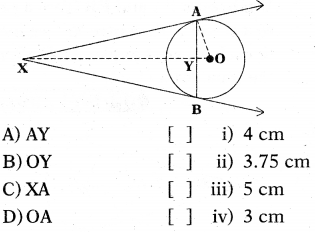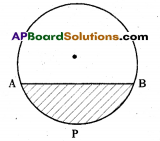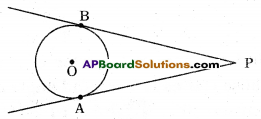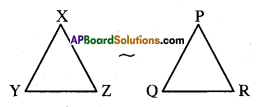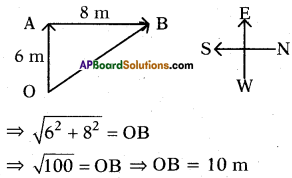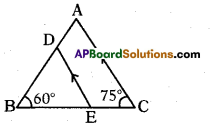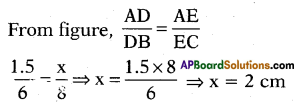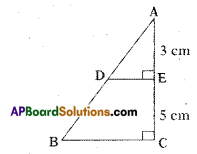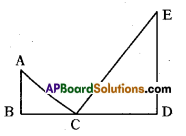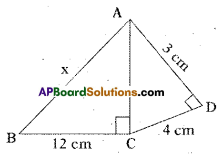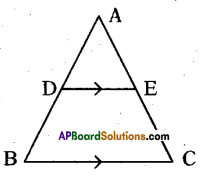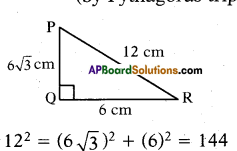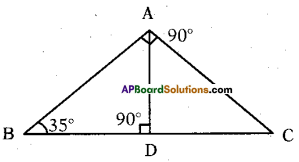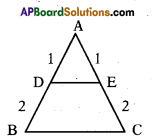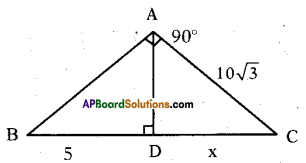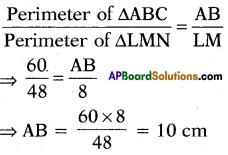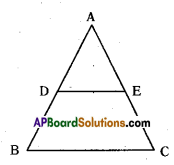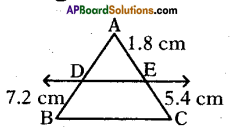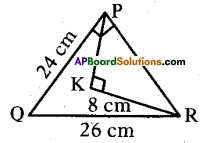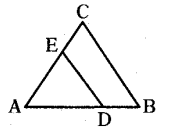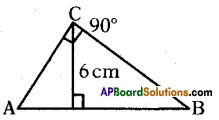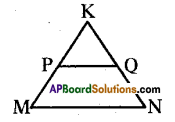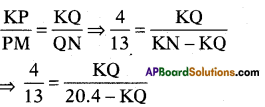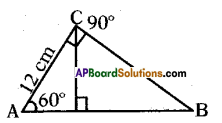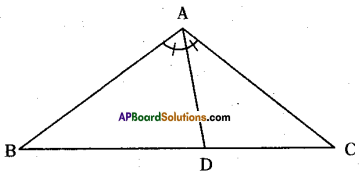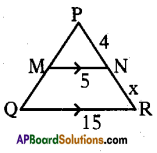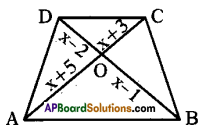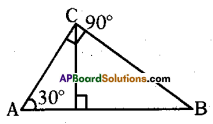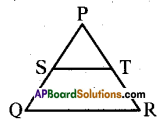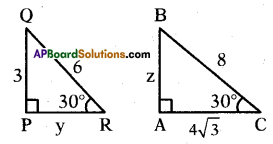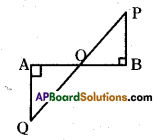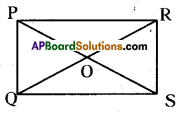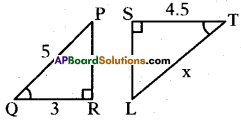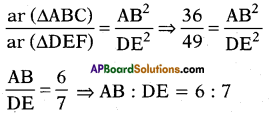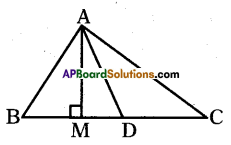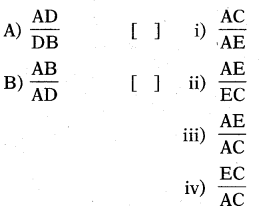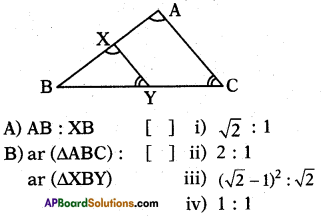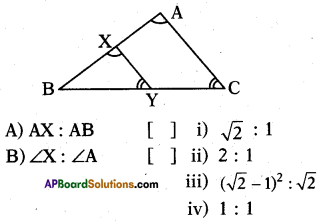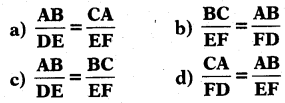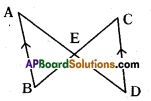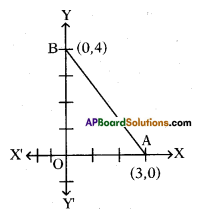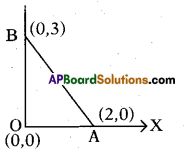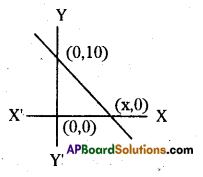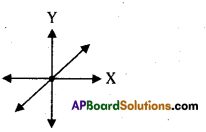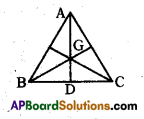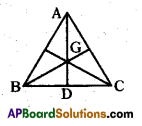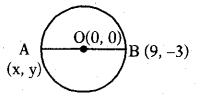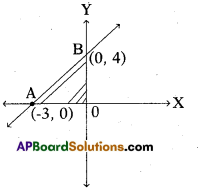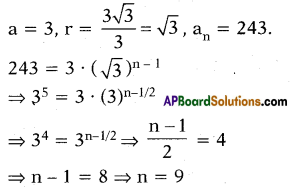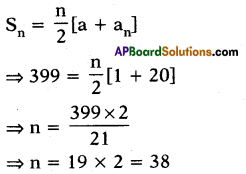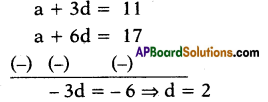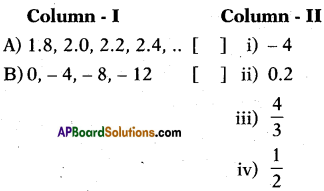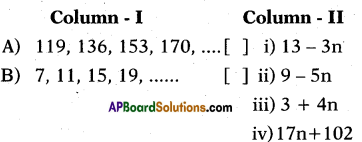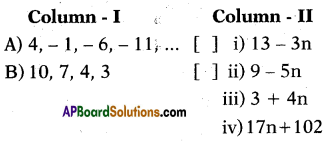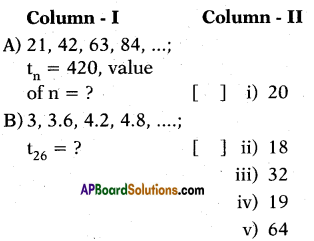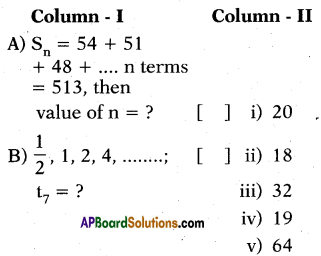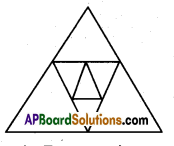Practice the AP 10th Class Maths Bits with Answers Chapter 11 Trigonometry on a regular basis so that you can attempt exams with utmost confidence.
AP State Syllabus 10th Class Maths Bits 11th Lesson Trigonometry with Answers
Question 1.
Find the value of cos 12° – sin 78°
Answer:
0
Explanation:
cos 12°- sin(90°- 12°)
⇒ cos 12° – cos 12° = 0
Question 2.
If x = cosec θ + cot θ and y = cosec θ – cot θ, then write the relation between ‘x’ and ‘y’
Answer:
xy = 1
Explanation:
xy = (cosec θ + cot θ) (cosec θ – cot θ)
⇒ cosec2 θ – cot2 θ = 1
Question 3.
Write a formula to cos (A – B).
Answer:
cos A cos B + sin A sin B
Question 4.
The value of cos (90 – θ).
Answer:
sin θ
Question 5.
In Δ ABC sin C = \(\frac {3}{5}\),then find cos A.
Answer:
\(\frac {3}{5}\)
Question 6.
Complete the value tan2 θ – sec2 θ.
Answer:
-1
Explanation:
-(sec2 θ – tan2 θ) = – 1

Question 7.
The value of sec (90 – A).
Answer:
cosec A
Question 8.
If cosec θ + cot θ = 5, then cosec θ – cot θ.
Answer:
\(\frac {1}{5}\)
Question 9.
If x = 2 sec θ; y = tan θ,then the value of x2 – y2.
Answer:
4
Explanation:
sec2 θ = \(\left(\frac{x}{2}\right)^{2}\),tan2 θ = \(\left(\frac{y}{2}\right)^{2}\)
⇒ sec2 θ – tan2 θ = \(\frac{x^{2}}{4}-\frac{y^{2}}{4}\)
⇒ 4 = x2 – y2
Question 10.
If √3 tan θ = 1,then the value of θ.
A.
30°
Question 11.
The value of (sec 60)(cos 60).
Answer:
1
Question 12.
How much the value of sin (60 + 30)?
Answer:
1

Question 13.
If sec θ + tan θ = \(\frac{1}{2}\) then find sec θ – tan θ.
Answer:
2
Question 14.
The value of cos(90 – θ).
Answer:
sin θ
Question 15.
Simplify: tan 26°. tan 64°
Answer:
1
Explanation:
tan 26° . tan 64°
⇒ tan 26° . tan (90° – 26°)
⇒ tan 26° . cot 26° = 1
Question 16.
How much value of the angle ‘θ’ in the figure?

Answer:
30°
Explanation:
sin θ = \(\frac{\mathrm{AB}}{\mathrm{AC}}=\frac{2}{4}=\frac{1}{2}\) = sin 30°
∴θ = 30°
Question 17.
Find the value of \(\frac{1-\tan ^{2} 45^{\circ}}{1+\tan ^{2} 45^{\circ}}\).
Answer:
0
Explanation:
\(\frac{1-\tan ^{2} 45^{\circ}}{1+\tan ^{2} 45^{\circ}}\) = \(\frac{1-1}{1+1}=\frac{0}{2}\) = 0
Question 18.
If sin x = \(\frac{5}{7}\), then find the value of cosec x.
Answer:
\(\frac{7}{5}\)
Explanation:
sin x = \(\frac{5}{7}\) ⇒ cosec x = \(\frac{7}{5}\)

Question 19.
Given ∠A = 75°, ∠B = 30°,then find the value of tan (A – B).
Answer:
1
Explanation:
tan (75° – 30°) = tan 45° = 1
Question 20.
If sec θ + tan θ = \(\frac{1}{3}\),then find the value of sec θ – tan θ.
Answer:
3
Explanation:
⇒ sec θ + tan θ = \(\frac{1}{3}\)
⇒ sec θ – tan θ = 3
Question 21.
If cosec θ + cot θ = 2,then find the value of cos θ.
Answer:
\(\frac{3}{5}\)
Explanation:

Question 22.
If cos (A + B) = 0, cos B = \(\frac{\sqrt{3}}{2}\),then
how much value of A?
Answer:
60°
Explanation:
cos (A + B) = 0, cos B = \(\frac{\sqrt{3}}{2}\)
⇒ cos B = cos 30°
⇒ A + B = 90°
⇒ A + 30° = 90°
∴ A = 90°- 30° = 60°
Question 23.
If sec θ – tan θ = 3, then find the value of sec θ + tan θ.
Answer:
\(\frac{1}{3}\)
Question 24.
If sin 2θ = cos 3θ, then how the value of θ.
Answer:
18°
Explanation:
sin 2θ = cos 3θ
⇒ 2θ + 3θ = 90°
⇒ 5θ = 90°
θ = 18°

Question 25.
If cos θ = \(\frac{3}{5}\), then find the value of sin θ.
Answer:
\(\frac{4}{5}\)
Explanation:
cos θ = \(\frac{3}{5}\) ⇒ sin θ = \(\frac{4}{5}\)
Question 26.
Simplify : cos 60° + sin 30°.
Answer:
1
Explanation:
cos 60° + sin 30° = \(\frac{1}{2}+\frac{1}{2}=\frac{2}{2}\) = 1
Question 27.
If sec A + tan A = \(\frac{1}{5}\), then find the value of sec A – tan A.
Answer:
5
Question 28.
sin (90 – A) = \(\frac{1}{2}\) , then how much the value A?
A.
60°
Question 29.
If cot A = \(\frac{5}{12}\), then find the value of sin A + cos A.
Answer:
\(\frac{17}{13}\)
Question 30.
Write any value which is not possible for sin x?
Answer:
\(\frac{5}{4}\)
Explanation:
sin x = \(\frac{5}{4}\) > 1, so it is not possible.

Question 31.
If sin θ = cos θ (0 < θ < 90), then the value of tan θ + cot θ.
Answer:
2
Explanation:
sin θ = cos θ
⇒ 0 = 45°
⇒ tan 45° + cot 45° = 2
Question 32.
If sec θ + tan θ = 3, then find the value of sec θ – tan θ.
Answer:
\(\frac{1}{3}\)
Question 33.
In ΔABC; AB = c, BC = a, AC = b and ∠BAC = 0, then calculate the value of area of ΔABC is ………………(θ is acute)
Answer:
\(\frac{1}{2}\) bc sin θ
Question 34.
Write the value of tan θ in terms of cosec θ.
Answer:
\(\frac{1}{\sqrt{\operatorname{cosec}^{2} \theta-1}}\)
Question 35.
Observe the following:
(I) sin2 20° + sin2 70° = 1
(II) log2 (sin 90°) = 1
Which one is CORRECT?
Answer:
(I) only
Question 36.
Simplify : tan 36°. tan 54° + sin 30°
Answer:
\(\frac{3}{2}\)
Explanation:
tan 36° . tan (90 – 36°) + sin 30°
⇒ tan 36° . cot 36° + \(\frac{1}{2}\)
⇒ 1 + \(\frac{1}{2}=\frac{3}{2}\)

Question 37.
If sin A = \(\frac{24}{25}\), then find the value of sec A.
Answer:
\(\frac{25}{7}\)
Question 38.
Which one of the following is NOT defined?
sin 90°, cos 0°, sec 90°, cos 90°.
Answer:
sec 90°
Explanation:
sec 90° is not defined
Question 39.
Simplify:\(\sqrt{\frac{1-\cos ^{2} A}{1+\cot ^{2} A}}\)
Answer:
sin2A
Explanation:
\(\sqrt{\frac{\sin ^{2} A}{\operatorname{cosec}^{2} A}}\) = \(\sqrt{\sin ^{4} A}\) = sin2A
Question 40.
If cot θ – cosec θ = p, then find cot θ + cosec θ.
Answer:
\(\frac{-1}{\mathrm{p}}\)
Question 41.
Express tan θ in terms of cos θ.
Answer:
\(\frac{\sqrt{1-\cos ^{2} \theta}}{\cos \theta}\)
Question 42.
Who was introduced Trigonometry?
Answer:
Hipparchus

Question 43.
\(\frac{\sin ^{4} \theta-\cos ^{4} \theta}{\sin ^{2} \theta-\cos ^{2} \theta}\) equal to
Answer:
1
Explanation:
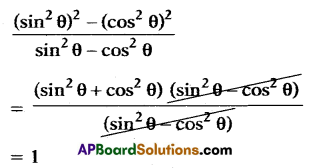
Question 44.
sin247° + sin243° equal to
Answer:
1
Question 45.
sin 2A equal to
Answer:
2sin A cos A
Question 46.
sin 30° + cos 60° equal to
Answer:
1
Question 47.
sec4A – sec2A equal to
Answer:
tan4 A – tan2 A
Explanation:
sec4 A – sec2A
⇒1 + tan4 A – (1 + tan2 A)
⇒ tan4 A – tan2 A
Question 48.
Find the value of \(\frac{\tan ^{2} \theta}{1+\tan ^{2} \theta}\).
Answer:
sin2 θ

Question 49.
2sin 45°. cos 45° equal to
Answer:
1
Question 50.
sin 81° equal to
Answer:
cos 9°
1
Question 51.
tan θ = \(\frac{1}{\sqrt{3}}\), then find cos θ.
Answer:
\(\frac{\sqrt{3}}{2}\)
Question 52.
If cos θ = \(\frac{1}{2}\); then find cos\(\frac{\theta}{2}\)
Answer:
\(\frac{\sqrt{3}}{2}\)
Explanation:
cos θ = \(\frac{1}{2}\)
⇒ cos θ = cos 60° ⇒ θ = 60°
⇒ cos\(\frac{\theta}{2}\) ⇒ cos 30° = \(\frac{\sqrt{3}}{2}\)
Question 53.
\(\frac{\cos \theta}{1-\tan \theta}+\frac{\sin \theta}{1-\cot \theta}\) equal to
Answer:
cos θ + sin θ
Question 54.
cos 300° equal to
Answer:
\(\frac{1}{2}\)
Explanation:
cos (270° + 30°) = sin 30° =\(\frac{1}{2}\)

Question 55.
\(\frac{\sin \theta}{\sqrt{1-\sin ^{2} \theta}}\) equal to
Answer:
tan θ
Explanation:

Question 56.
(1 + tan2 θ)cos2 θ equal to
Answer:
1
Question 57.
If 3 tan θ = 1; then find θ.
Answer:
30°
Question 58.
\(\frac{\sqrt{\sec ^{2} \theta-1}}{\sec \theta}\) equal to
Answer:
sin θ
Explanation:

Question 59.
\(\frac{1}{\sqrt{1+\tan ^{2} \theta}}\) equal to
Answer:
cos θ
Question 60.
Find the value of cosec 60° × cos 90°.
Answer:
0

Question 61.
sec2 θ + cosec2 θ equal to
Answer:
sec2 θ.cosec2 θ
Explanation:
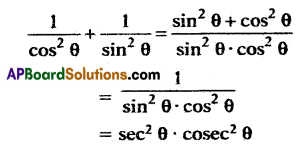
Question 62.
sec2 33° – cot2 57° equal to
Answer:
1
Question 63.
If sin θ = \(\frac{11}{15}\), then find cos θ.
Answer:
\(\frac{2 \sqrt{26}}{15}\)
Question 64.
equal to \(\frac{\tan \theta}{\sqrt{1+\tan ^{2} \theta}}\)
Answer:
sin θ
Question 65.
If sin θ = \(\frac{\mathbf{a}}{\mathbf{b}}\); cos θ = \(\frac{\mathbf{c}}{\mathbf{d}}\); then find tan θ.
Answer:
\(\frac{\mathrm{ad}}{\mathrm{bc}}\)
Explanation:

Question 66.
tan (A+B) equal to
Answer:
\(\frac{\tan A+\tan B}{1-\tan A \cdot \tan B}\)
Question 67.
If sin A = \(\frac{1}{\sqrt{2}}\) ; then find tan A.
Answer:
1

Question 68.
sin\(\frac{\pi}{6}\) + cos\(\frac{\pi}{3}\) equal to
Answer:
1
Question 69.
Find the value of cos 75°.
Answer:
sin 15°
Explanation:
cos 75° = cos (90° – 15°) = sin 15°
Question 70.
If sin 0 = \(\frac{1}{2}\); then find cos \(\frac{3 \theta}{2}\).
Answer:
\(\frac{1}{\sqrt{2}}\)
Question 71.
\(\frac{1}{\sec ^{2} A}+\frac{1}{\operatorname{cosec}^{2} A}\) equal to
Answer:
1
Explanation:

Question 72.
sin 240° equals to
Answer:
–\(\frac{\sqrt{3}}{2}\)
Explanation:
sin 240° = sin (270° – 30°)
= -cos 30°= \(\frac{-\sqrt{3}}{2}\)

Question 73.
If sec θ + tan θ = \(\frac{1}{5}\) ,then find sin θ.
Answer:
\(\frac{12}{13}\)
Question 74.
tan 240° equal to
Answer:
√3
Question 75.
Find the value of
sin 60° cos 30°+ cos 60°. sin 30°.
Answer:
1
Explanation:

Question 76.
\(\frac{1}{1-\sin \theta}+\frac{1}{1+\sin \theta}\) equal to
Answer:
2sec2 θ
Explanation:

Question 77.
tan 0° equal to
Answer:
0
Question 78.
\(\frac{\sqrt{1+\tan ^{2} \theta}}{\sqrt{1+\cot ^{2} \theta}}\) equal to
Answer:
tan θ

Question 79.
\(\frac{\sin 18^{\circ}}{\cos 72^{\circ}}\) equal to
Answer:
1
Question 80.
If sin θ = cos θ, then find θ.
Answer:
45°
Question 81.
In right triangle ΔABC; ∠B= 90°; tan C = \(\frac{5}{12}\) , then find the length of hypotenuse.
Answer:
13
Explanation:

By Py thagoras theorem,
AC2 = AB2 + BC2
AC2 = 52 + 122
= 25 + 144= 169
⇒ AC = hypotenuse = 13
Question 82.
If A, B are acute angles ;
sin(A – B)= \(\frac{1}{2}\); cos (A + B) = \(\frac{1}{2}\), then find B.
Answer:
15° (or) \(\frac{\pi}{12}\)
Explanation:
sin (A – B) = \(\frac{1}{2}\) = sin30°
A – B = 30°

Question 83.
cos (270° – θ) equal to
Answer:
-sin θ
Question 84.
Find the value of
cos 0° + sin 90° + √2sin 45°.
Answer:
3
Explanation:
1 + 1 + √2.\(\frac{1}{\sqrt{2}}\) = 1 + 1 + 1 = 3

Question 85.
If tan θ = \(\frac{1}{\sqrt{3}}\); then find cos θ.
Answer:
\(\frac{\sqrt{3}}{2}\)
Explanation:
tan θ = \(\frac{1}{\sqrt{3}}\) = tan 30°
⇒ θ = 30°
∴ cos θ = cos 30° = \(\frac{\sqrt{3}}{2}\)
Question 86.
Equal to cosec (90 + θ).
Answer:
sec θ
Question 87.
sin θ. sec θ equals to
Answer:
tan θ
Question 88.
Find the value of 3sin2 45°+2cos2 60°.
Answer:
2
Explanation:
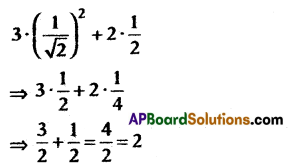
Question 89.
Find the value of tan2 30° + 2 cot2 60°.
Answer:
1
Explanation:

Question 90.
Find the value of secA.\(\sqrt{1-\sin ^{2} A}\)
Answer:
1

Question 91.
If 5 sin A= 3; then find sec2 A – tan2 A.
Answer:
1
Explanation:
sin A = \(\frac{3}{5}\) ⇒ sec2A = tan2A = 1
Question 92.
Find the value of cos 240°.
Answer:
–\(\frac{1}{2}\)
Question 93.
If sin θ. cosec θ = x; then find x.
Answer:
1
Question 94.
sin(45°+ θ) – cos(45°- θ).
Answer:
0
Question 95.
Find the value of cos2 17° – sin2 73°.
Answer:
0
Explanation:
cos2 17°- sin2 73°
= cos2 (90 – 73) – sin2 73°
= sin2 73° – sin2 73° = 0
Question 96.
Find the value of sin2 60° – sin2 30°.
Answer:
\(\frac{1}{2}\)

Question 97.
ten θ is not defined when θ is equal to
Answer:
90°
Question 98.
Find the value of sin 45° + cos 45°.
Answer:
√2
Explanation:

Question 99.
Simplify: \(\frac{1-\sec ^{2} A}{\operatorname{cosec}^{2} A-1}\)
Answer:
– tan4A
Question 100.
Find the value of sin θ. cosec θ+ cos θ. sec θ + tan θ. cot θ.
Answer:
3
Explanation:

= 1 + 1 + 1 = 3
Question 101.
If A = 30°, then sin 2A equals to
Answer:
\(\frac{\sqrt{3}}{2}\)
Question 102.
If sec θ = 3k and tan θ = \(\frac{3}{\mathbf{k}}\), then find the value of (k2 – \(\frac{1}{\mathbf{k}^{2}}\))
Answer:
\(\frac{1}{9}\)
Explanation:
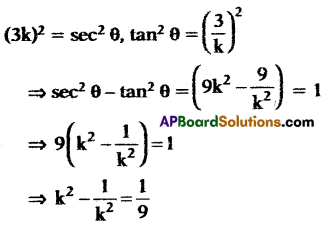
Question 103.
If tan θ + sec θ = 8, then find sec θ – tan θ.
Answer:
\(\frac{1}{8}\)

Question 104.
If sin θ = \(\frac{12}{13}\), then find tan θ.
Answer:
\(\frac{12}{5}\)
Question 105.
In a right angled ΔABC, right angle at C if tan A = \(\frac{8}{15}\), then find the value of cosec2 A – 1.
Answer:
\(\frac{225}{64}\)
Explanation:
tan A = \(\frac{8}{15}\),
cosec 2 A – 1 = cot2A = \(\left(\frac{15}{8}\right)^{2}=\frac{225}{64}\)
Question 106.
Find the value of \(\frac{2 \tan 30^{\circ}}{1+\tan ^{2} 30^{\circ}}\)
Answer:
sin 60°
Question 107.
If sin A = ;\(\frac{1}{\sqrt{2}}\) then find tan A
Answer:
1
Question 108.
In ΔABC, sin \(\left(\frac{B+C}{2}\right)\) equal to .
Answer:
A. cos\(\frac{A}{2}\)
Question 109.
tan 26°. tan 64° equal to
Answer:
1
Explanation:
tan 26° . tan 64°
= tan 26° . tan (90° – 26°)
= tan 26° . cot 26° = 1
Question 110.
cos2 θ equal to
Answer:
1 – sin2 θ

Question 111.
If tan A = \(\frac{3}{4}\) then find sec2 A – tan2 A.
Answer:
1
Question 112.
sin4 θ – cos4 θ equal to
Answer:
2sec2 θ – 1
Question 113.
\(\frac{\sqrt{1-\cos ^{2} \theta}}{\cos \theta}\) equal to
Answer:
tan θ
Explanation:

Question 114.
sin(90 – Φ) equal to
Answer:
cos Φ
Question 115.
sec θ – tan θ = \(\frac{1}{n}\), then find sec θ + tan θ.
Answer:
n
Question 116.
x = 2 cosec θ, y = 2 cot θ; find x2 – y2.
Answer:
4
Question 117.
tan θ is not defined if θ.
Answer:
90°

Question 118.
sec θ is not defined if θ.
Answer:
90°
Question 119.
tan2 Φ – sec2 Φ equal to
Answer:
-1
Question 120.
\(\left|\begin{array}{ll}
\tan \theta & \sec \theta \\
\sec \theta & \tan \theta
\end{array}\right|\)
Answer:
1
Explanation:
\(\left|\tan ^{2} \theta-\sec ^{2} \theta\right|=|-1|\) = 1
Question 121.
sin 225° equal to
Answer:
\(\frac{-1}{\sqrt{2}}\)
Question 122.
cos (x – y) equal to
Answer:
cos x cos y + sin x sin y
Question 123.
\(\frac{\sec 35^{\circ}}{\operatorname{cosec} 55^{\circ}}\) equal to
Answer:
1
Explanation:
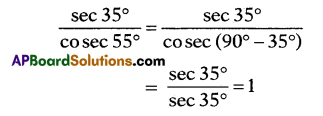

Question 124.
\(\frac{1}{\sec ^{2} A}+\frac{1}{\operatorname{cosec}^{2} A}\) equal to
Answer:
1
Question 125.
sin (-θ) equal to
Answer:
-sin θ
Question 126.
cosec (270 – θ) equal to
Answer:
-sec θ
Question 127.
sec (90 + θ) equal to
Answer:
-cosec θ
Question 128.
tan (360 – θ) equal to
Answer:
-tan θ
Question 129.
cos (-θ) equal to
Answer:
cos θ
Question 130.
sin (180 – θ) equal to
Answer:
sin θ

Question 131.
cos (270 – θ) equal to
Answer:
-sin θ
Question 132.
Find the maximum value of cos θ.
Answer:
1
Question 133.
Find the minimum and maximum values of tan θ.
Answer:
(- ∞ ,∞ )
Question 134.
sin 420° equal to
Answer:
\(\frac{\sqrt{3}}{2}\)
Question 135.
sec 240° equal to
Answer:
-2
Question 136.
cos 0° + sin 90° + √3 cosec 60° equal to
Answer:
4
Explanation:
1 + 1 + 3 . \(\frac{2}{\sqrt{3}}\) = 4
Question 137.
sec θ + tan θ = \(\frac{1}{2}\); then find sin θ.
Answer:
\(\frac{12}{13}\)

Question 138.
sin 45°.cos 45° + √3 sin 60° equal to
Answer:
2
Question 139.
tan 30° + cot 30° equal to
Answer:
\(\frac{4}{\sqrt{3}}\)
Question 140.
tan (A – B) equal to
Answer:
\(\frac{\tan A-\tan B}{1+\tan A \tan B}\)
Question 141.
If sin A = \(\frac{3}{5}\); then find sin (90 + A).
Answer:
\(\frac{4}{5}\)
Explanation:
sin A = \(\frac{3}{5}\), sin (90 + A) = cos A = \(\frac{4}{5}\)
Question 142.
Find the value of cos 1°.cos 2°.cos 3°……………, cos 180°.
Answer:
0
Explanation:
cos 1° × cos 2° × cos 3° × …………….. × cos 90° × ……….. × cos 180°
cos 1° × cos 2° × cos 3° × …………. × 0 × …………. × (- 1) = 0
Question 143.
Find the value of cos217° – sin2 73°.
Answer:
0
Question 144.
If cosec θ + cot θ = 2; then find cosec θ – cot θ.
Answer:
\(\frac{1}{2}\)

Question 145.
cosec 60°. sec 60° equal to
Answer:
\(\frac{4}{\sqrt{3}}\)
Question 146.
sin (A – B) equal to
Answer:
sin A cos B – cos A sin B
Question 147.
If tan (15°+ B)= √3 ; then find B.
Answer:
45°
Explanation:
tan (15° + B) = √3 = tan 60°
15 + B = 60 ⇒B = 60°- 15° = 45°
Question 148.
Simplify: \(\frac{\sin (90-\theta) \sin \theta}{\tan \theta}\) – 1
Answer:
-sin2 θ
Question 149.
sin 450° equal to
Answer:
1
Question 150.
cos 150° equal to
Answer:
–\(\frac{\sqrt{3}}{2}\)
Question 151.
If sin θ = \(\frac{1}{2}\) ; then find cot θ.
Answer:
√3

Question 152.
Find the value of sin 29° – cos 61°
Answer:
0
Question 153.
If tan θ = 1; then find cos θ.
Answer:
\(\frac{1}{\sqrt{2}}\)
Question 154.
cos (A + B) equal to
Answer:
cos A cos B – sin A sin B
Question 155.
Express tan θ, in terms of sin θ.
Answer:
\(\frac{\sin \theta}{\sqrt{1-\sin ^{2} \theta}}\)
Question 156.
sin θ + sin2 θ = 1, then find cos2 θ + cos4 θ.
Answer:
1
Question 157.
in ΔABC,write tan(\(\frac{B+C}{2}\))equal to
Answer:
Cot (\(\frac{\mathrm{A}}{2},\))
Explanation:
A + B + C = 180°
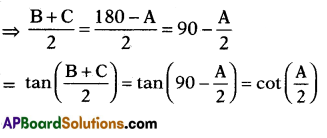

Question 158.
(cos A + sin A)2 + (cos A – sin A)2 equal to
Answer:
2
Question 159.
cos(180 – θ) equal to
Answer:
– cos θ
Question 160.
Find the value of (cosec θ – cot θ).
Answer:
\(\frac{1-\cos \theta}{\sin \theta}\)
Explanation:
cosec θ – cot θ
= \(\frac{1}{\sin \theta}-\frac{\cos \theta}{\sin \theta}=\frac{1-\cos \theta}{\sin \theta}\)
Question 161.
sin2 75° + cos2 75° equal to
Answer:
1
Question 162.
If cos θ. sin θ = \(\frac{1}{2}\) ; then find tan θ.
Answer:
1
Explanation:
cos θ . sin θ = cos 45° . sin 45°
= \(\frac{1}{\sqrt{2}} \cdot \frac{1}{\sqrt{2}}=\frac{1}{2}\)
Then tan 45° = 1.
Question 163.
For which value of cosine equal to sin 81°.
Answer:
cos 9°.
Question 164.
sin 750° equal to
Answer:
\(\frac{1}{2}\)

Question 165.
\(\frac{\sin \theta-2 \sin ^{3} \theta}{2 \cos ^{3} \theta-\cos \theta}\) equal to
Answer:
tan θ
Explanation:
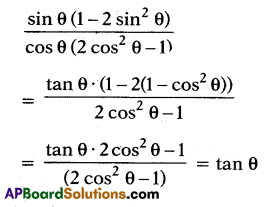
Question 166.
If sin(A+B) = 1; sin B = \(\frac{1}{2}\) ; then find A.
Answer:
60°
Explanation:
sin (A + B) = 1 = sin 90°
A + B = 90°
sin B = sin 30° ⇒ B = 30°
A + 30° = 90° ⇒ A = 60°
Question 167.
If tan θ = √3 , then find sec θ.
Answer:
2
Explanation:
tan θ = √3 = tan 60° ⇒ θ = 60°
sec 60° = 2
Question 168.
Find the value of
cos 0°+ sin 90° + √3 cosec 60°.
Answer:
4
Question 169.
\(\sqrt{\sec ^{2} \theta+\operatorname{cosec}^{2} \theta}\) equal to
Answer:
sec θ . cosec θ
Explanation:

Question 170.
Find the value of
cos 60°. cos 30° – sin 60°. sin30°.
Answer:
0
Question 171.
cot2θ – \(\frac{1}{\sin ^{2} \theta}\) equal to
Answer:
-1
Explanation:
cot2 θ – cosec2 θ = – 1

Question 172.
π radians equal into degrees.
Answer:
180°
Question 173.
sin (A + B). cos(A – B) + sin (A – B). cos (A + B) equal to
Answer:
sin 2A
Question 174.
If cos (A+B) = 0, cos B = \(\frac{\sqrt{3}}{2}\) ;then find A.
Answer:
60°
Question 175.
cos6 θ + sin6 θ equal to .
Answer:
1 – 3 sin2 θ.cos2 θ
Explanation:
cos6 θ + sin6 θ = (cos2 θ)3 + (sin2 θ)3
a3 + b3 = (a + b) – 3ab (a + b)
= (sin2 θ + cos2 θ)3
– 3 sin2 θ cos2 θ (sin2 θ + cos2 θ)
= 1 – 3 sin2 θ cos2 θ (1)
= 1 – 3 sin2 θ cos2 θ
Question 176.
sin 225° equal to
Answer:
–\(\frac{1}{\sqrt{2}}\)
Question 177.
sin 180° equal to
Answer:
0
Question 178.
If x = 2 cosec θ; y = 2 cot θ; then find x2 – y2.
Answer:
4
Explanation:
\(\frac{\mathrm{x}}{2}\) = cosec θ, \(\frac{\mathrm{y}}{2}\) = cot θ
cosec2 θ – cot2 θ = \(\left(\frac{x}{2}\right)^{2}-\left(\frac{y}{2}\right)^{2}\)
1 = \(\frac{x^{2}}{4}-\frac{y^{2}}{4}\)
x2 – y2 = 4

Question 179.
cos θ. tan θ equal to
Answer:
sin θ
Explanation:
cos θ = \(\frac{\sin \theta}{\cos \theta}\) = sin θ
Question 180.
If cot2 θ = 3; then find cosec θ.
Answer:
2
Explanation:
cot θ = √3 = cot 30° ⇒ θ = 30°
∴ cosec 30° = 2.
Question 181.
If sec θ = cosec θ; then find the value of θ.
Answer:
\(\frac{\pi}{4}\)
Question 182.
\(\frac{\tan \theta \cdot \sqrt{1-\sin ^{2} \theta}}{\sqrt{1-\cos ^{2} \theta}}\) equal to
Answer:
1
Explanation:

Question 183.
cos(x – y) equal to
Answer:
cos x cos y + sin x sin y
Question 184.
Simplify : cosec 31° – sec 59°
Answer:
0
Explanation:
cosec 31° – sec (90° – 31°)
[∵ sec (90 – θ) = cosec θ]
= cosec 31° – cosec 31°
= 0
Question 185.
(sec 45° + tan 45°) (sec 45° – tan 45°) equal to
Answer:
1

Question 186.
If sin θ = \(\frac{\mathbf{a}}{\mathbf{b}}\); cos θ = \(\frac{\mathbf{c}}{\mathbf{d}}\), then find cot θ.
Answer:
\(\frac{\mathrm{bc}}{\mathrm{ad}}\)
Question 187.
\(\sqrt{\operatorname{cosec}^{2} \theta-\cot ^{2} \theta}\) equal to
Answer:
1
Question 188.
sin2 45° + cos2 45° + tan2 45° equal to
Answer:
2
Explanation:
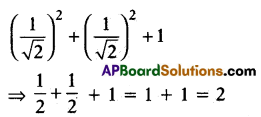
Question 189.
sec (360° – θ) equal to
Answer:
sec θ
Question 190.
tan θ. cot θ = sec θ. x ; then find x.
Answer:
cos θ
Explanation:
tan θ . cot θ = sec θ . x
\(\frac{\sin \theta}{\cos \theta} \cdot \frac{\cos \theta}{\sin \theta}=\frac{x}{\cos \theta}\)
cos θ = x
Question 191.
If 4 sin 30°. sec 60° = x tan 45°; then find x.
Answer:
4
Explanation:
4 . sin 30° – sec 60° = x . tan 45°
4 . \(\frac{1}{2}\) . 2 = x . 1
⇒ x = 4
Question 192.
In the following which are in geometric progression?
A) sin 30°, sin 45°, sin 60°
B) sec 30°, sec 45°, sec 60°
C) tan 30°, tan 45°, tan 60°
D) cos 45°, cos 60°, cos 90°
Answer:
C) tan 30°, tan 45°, tan 60°

Question 193.
(1 + tan2 A) (1 – sin2 A)
equal to
Answer:
1
Explanation:
sec2 A × cos2 A = 1
Question 194.
Find the value of
cos 60° cos 30° + sin 60°. sin 30°.
Answer:
\(\frac{\sqrt{3}}{2}\)
Explanation:
\(\frac{1}{2} \cdot \frac{\sqrt{3}}{2}+\frac{\sqrt{3}}{2} \cdot \frac{1}{2}\)
= \(\frac{\sqrt{3}}{4}+\frac{\sqrt{3}}{4}=\frac{2 \sqrt{3}}{4}=\frac{\sqrt{3}}{2}\)
Question 195.
\(\frac{1-\tan ^{2} 30^{\circ}}{1+\tan ^{2} 30^{\circ}}\) equal to
Answer:
\(\frac{1}{2}\)
Question 196.
cos(\(\frac{3 \pi}{2}\) + θ) equal to
Answer:
sin θ
Explanation:
cos (270 + θ) = sin θ
Question 197.
\(\sqrt{1+\cot ^{2} \theta}\) equal to
Answer:
cosec θ
Question 198.
If tan θ + cot θ = 2; then find tan2 θ + cot2 θ.
Answer:
2
Explanation:
tan θ + cot θ = 2
⇒ tan2 θ + cot2 θ + 2 . tan θ . cot θ = 4
⇒ tan2 θ + cot2 θ = 4 – 2 = 2
Question 199.
If sec θ = \(\frac{13}{12}\), then find sin θ.
Answer:
\(\frac{5}{13}\)

Question 200.
How much the value of
(sin θ + cos θ)2 + (sin θ – cos θ)2 ?
Answer:
2
Explanation:
(a + b)2 + (a – b)2 = 2(a2 + b2)
= 2 (sin2 θ + cos2 θ) = 2
Question 201.
(1 + tan θ)2 equal to
Answer:
sec2 θ + 2 tan θ
Question 202.
sin(A – B) = \(\frac{1}{2}\); cos (A+B) = \(\frac{1}{2}\). So
find A.
Answer:
45°
Explanation:

⇒ A = 45°
Question 203.
Find the value of tan 135°.
Answer:
-1
Question 204.
Find the value of \(\sqrt{1+\sin A} \cdot \sqrt{1-\sin A}\)
Answer:
cos A
Explanation:

Question 205.
Find the value of tan 60° – tan 30°.
Answer:
\(\frac{2 \sqrt{3}}{3}\)
Explanation:
tan 60° – tan 30°

Question 206.
In ΔABC, a = 3; b = 4; c = 5, then find cos A.
Answer:
4/5
Explanation:
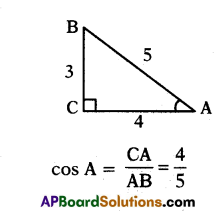

Question 207.
sin3 θ cos θ.cos3 θ sin θ equals to
Answer:
sin θ cos θ
Question 208.
If tan θ \(\frac{1}{\sqrt{3}}\) , then find the value of 7 sin2 θ + 3 cos2 θ.
Answer:
4
Explanation:
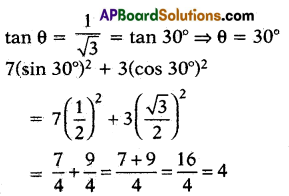
Question 209.
cot (270° – θ) equal to
Answer:
tan θ
Question 210.
(1 + tan2 60°)2 equals to
Answer:
16
Explanation:
[1 + (√3)2]2 = (1 + 3)2 = 42 = 16
Question 211.
sin (270° + θ) equal to
Answer:
– cos θ
Question 212.
If tan2 60° + 2 tan2 45° = x tan 45°, then find x.
Answer:
5
Explanation:
(√3)2 + 2(1)2 = x . 1
⇒ 3 + 2 = x ⇒ x = 5
Question 213.
cos2 0° + cos2 60° equal to
Answer:
5/4

Question 214.
Simplify : sin4 θ – cos4 θ
Answer:
2sin2 θ – 1
Question 215.
If α + β = 90° and α = 2β, then find cos2 β + sin2 β.
Answer:
1
Explanation:
α = 90 – β
⇒ 90 – β = 2β ⇒ 3β = 90° ⇒ β = 30°
∴ cos2 30° + sin2 30° = (\(\frac{\sqrt{3}}{2}\))2 + (\(\frac{1}{2}\))2
= \(\frac{3}{4}+\frac{1}{4}=\frac{4}{4}\) = 1
Question 216.
If sin θ = \(\frac{\mathbf{a}}{\mathbf{b}}\) , then find cos θ.
Answer:
\(\frac{\sqrt{b^{2}-a^{2}}}{b}\)
Question 217.
2sin θ = sin2 θ is true for the value of θ is
Answer:
0°
Question 218.
If sin θ = \(\frac{\mathbf{a}}{\mathbf{b}}\) , then find tan θ.
Answer:
\(\frac{a}{\sqrt{b^{2}-a^{2}}}\)
Question 219.
\(\frac{\sin \theta}{1+\cos \theta}\) is equal to
Answer:
\(\frac{1-\cos \theta}{\sin \theta}\)
Question 220.
If sin θ = cos θ, then find the value of 2 tan θ + cos2 θ.
Answer:
\(\frac{5}{2}\)
Explanation:
sin θ = cos θ ⇒ θ = 45°
2 tan 45° + cos2 45° = 2 + \(\frac{1}{2}=\frac{5}{2}\)

Question 221.
If sin x = cos x, 0 ≤ x ≤ 90°, then find x.
Answer:
45°
Question 222.
How much the maximum value of sin θ?
Answer:
1
Question 223.
In the figure find tan x.
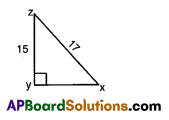
Answer:
\(\frac{15}{8}\)
Question 224.
sin A = cos B, then find A + B.
Answer:
90°
Question 225.
If cosec θ + cot θ = 3, then find cosec θ – cot θ.
Answer:
\(\frac{1}{3}\)
Question 226.
If tan 2A = cot (A – 18°) where 2A is an acute angle, then find A.
Answer:
36°
Explanation:
90 – 2A = A – 18°
⇒ 3A = 108° ⇒ A = 36°
Question 227.
sec 0° equal to
Answer:
1
Question 228.
cosec 300° equal to
Answer:
\(\frac{-2}{\sqrt{3}}\)

Question 229.
cos 240° equal to
Answer:
\(\frac{-1}{2}\)
Question 230.
\(\frac{\operatorname{cosec}^{2} \theta}{\cot \theta}\) – cot θ equal to
Answer:
tan θ
Question 231.
Find the minimum value of cos θ.
Answer:
-3
Question 232.
If sec θ = cosec θ; then find the value of θ in radians.
Answer:
\(\frac{\pi^{\mathrm{c}}}{4}\)
Explanation:
sec θ = cosec θ ⇒ θ = 45° = \(\frac{\pi^{\mathrm{c}}}{4}\)
Question 233.
Reciprocal of cot A.
Answer:
tan A
Question 234.
sin \(\frac{\pi^{\mathrm{c}}}{4}\) + cos 45° equal to
Answer:
√2
Question 235.
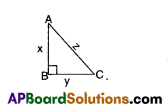
Answer:
\(\frac{\mathrm{x}}{\mathrm{z}}\)
Question 236.
If cosec θ = \(\frac{25}{7}\), then find cot θ.
Answer:
\(\frac{24}{7}\)

Question 237.
If sin (A + B) = \(\frac{\sqrt{3}}{2}\); cos B = \(\frac{\sqrt{3}}{2}\) , then find A.
Answer:
30°
Question 238.
tan 750° equal to
Answer:
\(\frac{1}{\sqrt{3}}\)
Question 239.
(1 – sec2 θ) (1 – cosec2 θ) equal to
Answer:
1
Question 240.
If cosec θ – cot θ = 4, then find cosec θ + cot θ.
Answer:
\(\frac{1}{4}\)
Question 241.
\(\sqrt{\tan ^{2} \theta+\cot ^{2} \theta+2}\) equal to
Answer:
tan θ + cot θ
Explanation:
= \(\sqrt{1+\tan ^{2} \theta+1+\cot ^{2} \theta}\)
= \(\sqrt{\sec ^{2} \theta+\operatorname{cosec}^{2} \theta}\)
= tan θ + cot θ
Question 242.
If cos θ = \(\frac{3}{5}\); then cos (-θ) equal to
Answer:
\(\frac{3}{5}\)
Question 243.
\(\frac{\sqrt{\operatorname{cosec}^{2} \theta-1}}{\operatorname{cosec} \theta}\)
equal to
Answer:
cos θ
Question 244.
If 5 sin A = 3, then find sec2 A – tan2 A.
Answer:
1

Question 245.
In the figure, find AB.
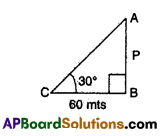
Answer:
20√3 (or) \(\frac{60}{\sqrt{3}}\)
Question 246.
If cot θ = x; then find cosec θ.
Answer:
\(\sqrt{\mathrm{x}_{1}^{2}+1}\)
Explanation:
cot θ = x ⇒ cosec θ = \(\sqrt{x^{2}+1}\)
Question 247.
\(\sqrt{\operatorname{cosec}^{2} \theta-\sin ^{2} \theta-\cos ^{2} \theta}\) equal to
Answer:
cot θ
Question 248.
Find the value of \(\frac{1}{\sec \theta-\tan \theta}\)
Answer:
sec θ + tan θ
Question 249.
sin (A + B) equal to
Answer:
sin A cos B + cos A sin B
Question 250.
\(\sqrt{(\sec \theta+1)(\sec \theta-1)}\) equal to
Answer:
tan θ
Question 251.
Find the value of tan 5° × tan 30° × 4 tan 85°.
Answer:
\(\frac{4}{\sqrt{3}}\)

Question 252.
cos 110°.cos 70° – sin 110°.sin 70° equal to ,
Answer:
-1
Explanation:
cos A . cos B – sin A . sin B
= cos (A + B)
= cos (110 + 70) = cos 180° = – 1
Question 253.
Find the value of tan 1°.tan 2°.tan 3°………….tan 89°.
Answer:
1
Question 254.
If cos θ = -cos θ; then Write θ in radian measure.
Answer:
\(\frac{\pi^{\mathrm{c}}}{3}\)
Question 255.
sec A = cosec B, then write A and B are ……….. angles.
Answer:
Complementary.
Question 256.
Find the value of tan 75°.
Answer:
2 + √3
Question 257.
\(\sqrt{\sec ^{2} \theta-\tan ^{2} \theta+\cot ^{2} \theta}\) equal to
Answer:
cosec θ
Question 258.
sin 240° + sin 120° equal to
Answer:
0
Question 259.
Find the value of
sec 70°. sin 20° + cos 20°. cosec 70°.
Answer:
2

Question 260.
If sec A + tan A = \(\frac{1}{3}\); then find sec A – tan A.
Answer:
3
Question 261.
(sec2 θ – 1)(1 – cosec2 θ)equal to
Answer:
-1
Question 262.
cos θ equal to
Answer:
\(\frac{\cot \theta}{\operatorname{cosec} \theta}\)
Question 263.
The radius of a circle is ‘r’; an arc of length ‘L’ is making an angle θ, at the centre of the circle, then find θ.
Answer:
L/r
Question 264.
cos (A – B) = \(\frac{1}{2}\); sin B = \(\frac{1}{\sqrt{2}}\), find measure of A.
Answer:
105°
Question 265.
If sec θ + tan θ = 4; then find cos θ.
Answer:
\(\frac{8}{17}\)
Question 266.
sec (360° – θ) equals to
Answer:
sec θ

Question 267.
If A is acute and tan A = \(\frac{1}{\sqrt{3}}\); then find sin ‘A’.
Answer:
\(\frac{1}{2}\)
Question 268.
(1 +cot2 45°)2 equal to
Answer:
4
Question 269.
\(\frac{\tan 45^{\circ}}{\operatorname{cosec} 30^{\circ}}+\frac{\sec 60^{\circ}}{\cot 45^{\circ}}\) equal to
Answer:
2\(\frac{1}{2}\)
Question 270.
\(\sqrt{\frac{\sec x+\tan x}{\sec x-\tan x}}\) equal to
Answer:
sec x + tan x
Question 271.
\(\frac{\sin ^{4} A-\cos ^{4} A}{\sin ^{2} A-\cos ^{2} A}\) equal to
Answer:
1
Question 272.
If the angle in a triangle are in the ratio of 1:2:3, then find the smallest angle in radins.
Answer:
π/6
Question 273.
If sin θ + cos θ = √2; then find the value of ‘θ’.
Answer:
45°
Question 274.
If cosec θ = 2 and cot θ = √3 P; where θ is an acute angle, then find the value of ‘P’.
Answer:
1

Question 275.
If cos 2θ = sin 4θ; here 2θ and 4θ are acute angles, then find the value of θ.
Answer:
15°
Explanation:
2θ + 4θ = 90°
⇒ 6θ = 90°⇒ θ = \(\frac{90^{\circ}}{6}\) = 15°
Question 276.
If sin 45°.cos 45°+cos 60° = tan θ, then find the value of θ.
Answer:
45°
Question 277.
If P, Q and R are interior angles of a ΔPQR, then tan \(\left(\frac{\mathbf{P}+\mathbf{Q}}{2}\right)\) equals
Answer:
cot (\(\frac{\mathrm{R}}{2}\))
Question 278.
If tan θ = 1, then find the value of \(\frac{5 \sin \theta+4 \cos \theta}{5 \sin \theta-4 \cos \theta}\)
Answer:
9
Explanation:
tan θ = 1 = tan 45° ⇒ θ = 45°
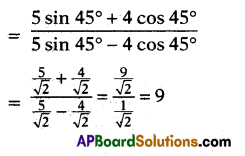
Question 279.
If sec 2A = cosec (A – 27°), where 2A is an acute angle, then find the measure of ∠A.
Answer:
39°
Explanation:
90 – 2A = A – 27°
⇒ 117° = 3A ⇒ A = \(\frac{117^{\circ}}{3}\) = 39°
Question 280.
If sin C = \(\frac{3}{5}\); then find cos A.

Answer:
3/5
Question 281.
Expressing tan θ, interms of sec θ.
Answer:
\(\sqrt{\sec ^{2} \theta-1}\)

Question 282.
If sin θ. cos θ = k; then find sin θ + cos θ.
Answer:
\(\sqrt{1+2 \mathrm{k}}\)
Question 283.
If \(\frac{1}{2}\) tan2 45° = sin2 A and ’A’ is acute, then find the value of ‘A’.
Answer:
45°
Question 284.
Find the value of (\(\frac{11}{\cot ^{2} \theta}-\frac{11}{\cos ^{2} \theta}\))
Answer:
-11
Explanation:
11 (tan2 θ – sec2 θ) = 11 (-1) = -11
Question 285.
Find the maximum value of \(\frac{1}{\sec \theta}\)
0° ≤ θ ≤ 90°.
Answer:
1
Question 286.
If π < θ < \(\frac{3 \pi}{2}\), then θ lies in which quadrant?
Answer:
Third quadrant
Question 287.
If cos θ = \(\frac{\sqrt{3}}{2}\) and’θ’is acute, then find the value of 4sin2 θ + tan2 θ.
Answer:
4/3
Question 288.
If tan θ = \(\frac{7}{8}\), then find the value of \(\frac{(1+\sin \theta)(1-\sin \theta)}{(1+\cos \theta)(1-\cos \theta)}\) ,
Answer:
\(\frac{64}{49}\)
Question 289.
When 0° ≤ 0 ≤ 90°; find the maximum value of sin θ + cos θ.
Answer:
√2

Question 290.
In ΔABC, ∠B = 90° ; ∠C = θ. From the figure find tan θ.
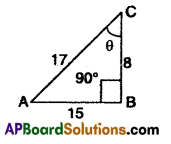
Answer:
\(\frac{15}{8}\)
Question 291.
If sin (x – 20°) = cos(3x – 10°), then find x’.
Answer:
15°
Question 292.
If sin (A – B)= \(\frac{1}{2}\); cos (A + B)= \(\frac{1}{2}\),
then find ‘B’.
Answer:
15°
Question 293.
If 5 tan θ = 4, then find die value of
\(\frac{5 \sin \theta-3 \cos \theta}{5 \sin \theta+3 \cos \theta}\)
Answer:
\(\frac{1}{7}\)
Question 294.
If 4 cos2 θ – 3 = 0, then find the value of sin θ.
Answer:
\(\frac{1}{2}\)
Choose the correct answer satisfying the following statements.
Question 295.
Statement (A): sin2 67° + cos2 67° = 1
Statement (B) : For any value of θ,
sin2 θ + cos2 θ = 1
i) Both A and B are true
ii) A is true, B is false
iii) A is false, B is true
iv) Both A and B are false.
Answer:
i) Both A and B are true
Explanation:
sin2 θ + cos2 θ = 1
⇒ sin2 67° + cos2 67° = 1
Hence, (i) is the correct option.
Question 296.
Statement (A): If cos A + cos2 A = 1,
then sin2 A + sin4 A = 2
Statement (B): 1 – sin2 A = cos2 A, for any value of A.
i) Both A and B are true
ii) A is true, B is false
iii) A is false, B is true
iv) Both A and B are false.
Answer:
iii) A is false, B is true
Explanation:
cos A + cos2 A = 1
cos A = 1 – cos2 A = sin2 A
∴ sin2 A + sin4 A = cos A + cos2 A = 1
⇒ sin2 A + sin4 A = 1
Hence, (iii) is the correct option.

Question 297.
Statement (A):
The value of sec2 10° – cot2 80° is 1.
Statement (B):
The value of sin 30° = \(\frac{1}{2}\)
i) Both A and B are true
ii) A is true, B is false
iii) A is false, B is true
iv) Both A and B are false.
Answer:
i) Both A and B are true
Explanation:
We have sec2 10° – cot2 80°
= sec2 10°-cot2 (90°- 10°)
= sec2 10° – tan2 10° = 1
Also, sin 30° = \(\frac{1}{2}\).
Hence, (i) is the correct option.
Question 298.
Statement (A) : The value of sin θ cos (90 – θ) + cos θ sin(90 – θ) ‘ equal to 1.
Statement (B): tan θ = sec(90 – θ)
i) Both A and B are true
ii) A is true, B is false
iii) A is false, B is true
iv) Both A and B are false.
Answer:
ii) A is true, B is false
Explanation:
sin θ cos (90 – θ) + Cos θ sin (90 – θ)
= sin θ . sin θ + cos θ – cos θ
= sin2 θ + cos2 θ = 1 and tan θ = cot (90 – θ)
Hence, (ii) is the correct option.
Question 299.
Statement (A) : The value of sin θ = \(\frac{4}{3}\) is not possible.
Statement (B): Hypotenuse is the largest side in any right angled triangle.
i) Both A and B are true
ii) A is true, B is false
iii) A is false, B is true
iv) Both A and B are false.
Answer:
i) Both A and B are true
Explanation:
sin 2 = \(\frac{\mathrm{P}}{\mathrm{H}}=\frac{4}{3}\)
Here, perpendicular is greater than the hypotenuse which is not possible in any right triangle.
Hence, (i) is the correct option.
Question 300.
Statement (A) : In a right angled triangle, if tan θ = \(\frac{3}{4}\), the greatest side of
the triangle is 5 units.
Statement (B) : (Greatest side hypotenuse)2 = (perpendicular)2 – (base)2
i) Both A and B are true
ii) A is true, B is false
iii) A is false, B is true
iv) Both A and B are false.
Answer:
i) Both A and B are true
Explanation:
Both A and B are correct and B is the correct explanation of the A.
Greatest side = \(\sqrt{(3)^{2}+(4)^{2}}\) = 5 units.
Hence, (i) is the correct option.
Question 301.
Statement (A) : In a right angled triangle, if cos θ \(\frac{1}{2}\) = and sin θ = \(\frac{\sqrt{3}}{2}\) then tan θ = √3
‘Statement (B) : tan θ = \(\frac{\sin \theta}{\cos \theta}\)
i) Both A and B are true
ii) A is true, B is false
iii) A is false, B is true
iv) Both A and B are false.
Answer:
i) Both A and B are true
Explanation:
Both A and B are correct and B is the correct explanation of the A.
tan θ = \(\frac{\sqrt{3}}{2}\) × 2 = √3
Hence, (i) is the correct option.
Question 302.
Statement (A) : sin 47° cos 43°.
Statement (B) : sin θ = cos(90 + θ),
where θ is an acute angle.
i) Both A and B .are true
ii) A is true, B is false
iii) A is false, B is true
iv) Both A and B are false.
Answer:
ii) A is true, B is false
Explanation:
A is correct, but B is not correct,
sin θ = cos (90 – θ)
sin 47° = cos (90 – 47)
= cos 43°
Hence, (ii) is the correct option.
❖ Study the given information and answer to the following questions.
In ΔABC, right angled at B.
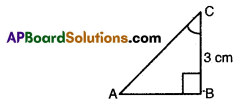
AB + AC = 9 cm and BC = 3 cm
Question 303.
The value of cot C is
Answer:
\(\frac{3}{4}\)
Explanation:
cot C = \(\frac{\mathrm{BC}}{\mathrm{AB}}=\frac{3}{4}\)
[∴ In ΔABC, By Pythagoras theorem,
AC2 = AB2 + BC2
AB = 4 cm, AC = 5 cm]

Question 304.
The value of sec C is
Answer:
\(\frac{5}{3}\)
Explanation:
sec C = \(\frac{A C}{B C}=\frac{5}{3}\)
Question 305.
sin2 C + cos2 C is equal to
Answer:
1
In figure, ΔABC has a right angle at B. If AB = BC = 1cm and AC = √2 cm.
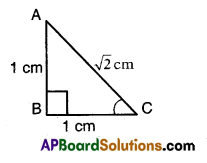
Explanation:
sin C= \(\frac{4}{5}\) ;cosC = \(\frac{3}{5}\)
L.H.S. = sin2 C + cos2 C
= \(\left(\frac{4}{5}\right)^{2}+\left(\frac{3}{5}\right)^{2}\)
= \(\frac{16+9}{25}\) = 1 = R.H.S.
Question 306.
Find sin C.
Answer:
\(\frac{1}{\sqrt{2}}\)
Explanation:
sin C = \(\frac{\mathrm{AB}}{\mathrm{AC}}=\frac{1}{\sqrt{2}}\)
Question 307.
Find cos C.
Answer:
\(\frac{1}{\sqrt{2}}\)
Explanation:
cos C =\(\frac{\mathrm{BC}}{\mathrm{AC}}=\frac{1}{\sqrt{2}}\)
Question 308.
Find tan C.
Answer:
1
The length of a pendulum is 80 cm. Its end describes an arc of length 16 cm.
Explanation:
tan C = \(\frac{\mathrm{AB}}{\mathrm{BC}}=\frac{1}{1}\) = 1
Question 309.
To find the length of the arc which formula is useful?
Answer:
l = r0
Question 310.
Calculate the angle of arc makes at centre.
Answer:
θ = \(\frac{1}{r}=\frac{16}{80}=\frac{1}{5}\)
In ΔPQR, right angled at Q,
PR + QR = 25 cm and PQ = 5 cm

Question 311.
Determine the value of “QR”.
Answer:
QR = 12 cm
Question 312.
Determine the value of “PR”.
Answer:
PR = 13 cm
Question 313.
Find the value of sin P.
Answer:
\(\frac{12}{13}\) cm
Question 314.
Find the value of cos P.
Answer:
\(\frac{5}{13}\) cm
Question 315.
Find the value of tan P.
Answer:
\(\frac{12}{5}\) cm
Question 316.
In ΔABC, ∠B = 90°, AB = 3 cm and BC = 4 cm, then match the column.
A) sin C [ ] i) 3/5
B) tanA [ ] ii) 4/5
C) cos C [ ] iii) 5/3
D) sec A [ ] iv) 4/3
Answer:
A – (i), B – (iv), C – (ii), D – (iii)
Question 317.
Match the following.

Answer:
A – (iv), B- (ii), C – (iii), D – (i)

Question 318.
Match the following.

Answer:
A – (ii), B- (i), C – (iii), D – (iv)
Question 319.
If sin θ = \(\frac{7}{25}\), then
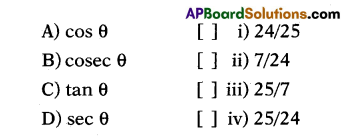
Answer:
A – (i), B- (iii), C – (ii), D – (iv)
Question 320.
Match the following.
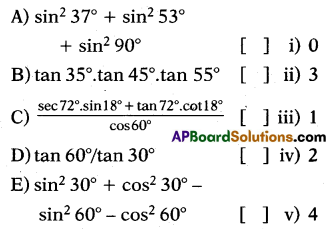
Answer:
A – (iv), B – (iii), C – (v), D – (ii), E – (i)
Question 321.
What is the value of
sec 16°- cosec 74° – cot 74° • tan 16° ?
Answer:
1 (one)
Question 322.
If x = 2019°, then what is the value of sin2 x + cos2 x ?
Solution:
If x = 2019°, then
sin2x + cos2x = sin22019° + cos22019° = 1 [∵ sin2θ + cos2θ = 1]
Question 323.
If x is in first quadrant and sin x = cos x, then what is the value of x?
Solution:
Given, sin x = cos x
We know, sin (90°- θ) = cos θ
So, cos x = sin(90° – x)
⇒ sin x = sin(90° – x)
[note : If sin A = sin B, then A = B]
⇒ x = 90° – x
⇒2x = 90°
∴ x = 45°
![]()
![]()
![]()
![]()

![]()
